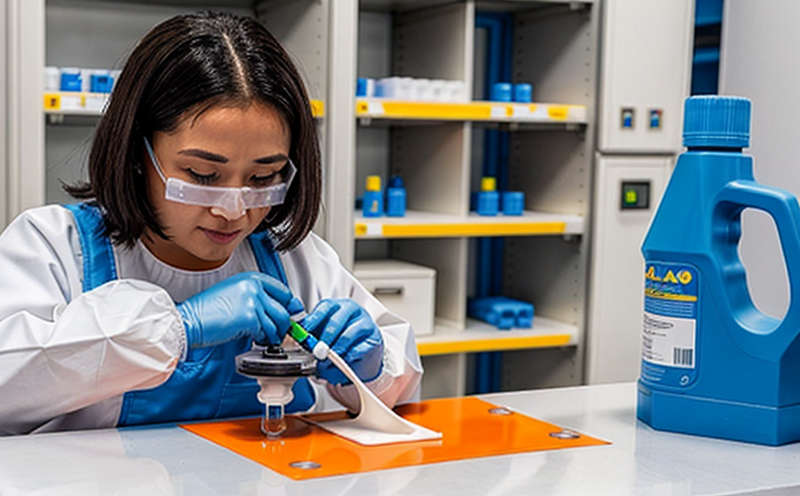ASTM D3433 Fracture Toughness of Adhesive Joints with Nanoparticles
The ASTM D3433 test method is widely recognized and used to measure the fracture toughness of adhesive joints. This service specifically targets the evaluation of adhesives containing nanoparticles, providing critical insights into their mechanical properties and durability.
Fracture toughness (KIc) is a key parameter that quantifies a material's resistance to crack propagation under static loading conditions. For nano-additive-filled adhesives, understanding this property helps in optimizing formulations for improved performance in demanding applications such as aerospace, automotive, and construction.
The presence of nanoparticles introduces unique challenges and opportunities. Nanoparticles can significantly alter the mechanical behavior of an adhesive by enhancing its toughness through mechanisms like crack deflection or bridging. This test ensures that these enhancements are accurately quantified, allowing for precise control over the properties of the final product.
ASTM D3433 specifies a method to evaluate fracture toughness using a compact tension (CT) specimen. The procedure involves preparing a standard CT specimen from the adhesive containing nanoparticles and subjecting it to controlled loading until failure. The energy absorbed during this process is used to calculate KIc.
The test setup requires careful preparation of the specimens, which involve precise alignment and clamping. The adhesives are typically mixed with nanoparticles according to specified ratios before application. Standardization in specimen preparation ensures consistency and comparability between different batches.
Instrumentation for this test includes specialized testing machines capable of applying controlled loading rates and measuring stress intensity factors accurately. Advanced sensors allow real-time monitoring of the specimen's deformation and fracture behavior, providing detailed insights into the adhesive's performance.
The results from ASTM D3433 are crucial for quality assurance and regulatory compliance. They help in ensuring that nanocomposites meet industry standards and specifications. This information is vital not only for R&D purposes but also for quality control during manufacturing processes.
Understanding fracture toughness with nanoparticles allows manufacturers to tailor their products more effectively, leading to better-performing materials in critical applications where high strength-to-weight ratios are essential.
The ASTM D3433 test method is complemented by other standards and techniques that provide a comprehensive picture of the material's properties. These include dynamic mechanical analysis (DMA) for viscoelastic behavior, scanning electron microscopy (SEM) for microstructure characterization, and tensile testing for overall strength evaluation.
In conclusion, ASTM D3433 is an essential tool in the development and quality assurance of nano-additive-filled adhesives. It provides valuable data that can drive innovation and ensure compliance with industry standards, ultimately leading to safer and more reliable products.
Benefits
- Accurate quantification of fracture toughness in nano-composites.
- Facilitates optimization of adhesive formulations for enhanced performance.
- Serves as a critical parameter in quality assurance protocols.
- Ensures compliance with industry standards and regulations.
- Supports research and development efforts in nanotechnology applications.
Why Choose This Test
- The ASTM D3433 test method is internationally recognized, ensuring credibility and acceptance of results across various sectors.
- It provides detailed insights into the mechanical behavior of nano-filled adhesives under controlled loading conditions.
- The test is versatile, applicable to a wide range of adhesive formulations containing nanoparticles.
- Results from this test can inform both R&D activities and production processes for improved product quality.
- It supports regulatory compliance and enhances the reputation of compliant products in competitive markets.
Competitive Advantage and Market Impact
Evaluating fracture toughness with ASTM D3433 offers a significant competitive advantage by providing precise data that can influence product design and performance. Companies that invest in this testing method can innovate faster, adapt to regulatory changes more effectively, and deliver superior products.
In the market for nano-filled adhesives, understanding the fracture toughness of these materials is crucial. Products with higher KIc values are often favored for their durability and reliability under stress conditions. This test helps manufacturers identify optimal nanoparticle compositions that enhance these properties, thereby gaining a competitive edge.
The ability to measure fracture toughness accurately also contributes to better risk management strategies. By knowing the precise mechanical behavior of adhesives containing nanoparticles, companies can anticipate potential issues early in development, reducing costly failures in production or use.
Moreover, this test supports sustainability goals by enabling the creation of more efficient and environmentally friendly products. With increased focus on sustainable practices, understanding how different nano-materials impact performance is vital for developing greener solutions without compromising quality.
In summary, ASTM D3433 fracture toughness testing not only enhances product quality but also contributes to market leadership through innovation and compliance with evolving standards.





